Introduction
The need for the consumption of animal protein is constantly increasing, mainly due to the demographic growth of the population. This increase in demand means that the livestock production sector must continuously make improvement actions to increase industrial yields. In addition to this situation, the trend of today’s society that demands safe meat, from farms that comply with quality and biosecurity regulations and specially apply and respect animal welfare, taking an increasingly growing interest in ecological management of the animals.
It is notorious the increasing demand for poultry products, as an alternative to red meats, which can promote diseases, such as diverticulosis (Böhm, 2015), diabetes (Pan et al., 2013) and the increased risk of suffering cancer (Wie et al., 2014). Under these circumstances of market demand, a lot of work has been done on genetic selection of birds (Sheng et al., 2015; Stratmann et al., 2016), especially in broiler (González-Cerón et al., 2015; Reyer et al., 2015), with the aim of obtaining a meat product in the shortest possible time and the reduction of the resources used in their production.
Increasing the production of poultry meat for the current demand, is no longer the only goal that the industry proposes, since it must consider demands of the market. This raises a reorganization of the production matrix, given that production systems must consider ecological aspects (Onrust et al., 2015; Ricke, 2015), and this is why the broilers industry has to evolve according to the market trend, becoming a great challenge for bird producers. It is meritorious all the research that has currently done in the area of new alternatives for avian management; and specially to replace artificial chemicals; such as antibiotics (Diaz-Sanchez et al., 2015) that can cause problems in the consumer’s organism.
The disadvantage of finding traces of residues of different chemicals used in normal management for the production of white meat consumption is not the result of the absence of regulations that govern a country or international, because by law, these are worldwide. Rather, it arises when drug withdrawal times is not correctly established at the farm level (Beyene, 2016; Muhammad Danish Mund et al., 2017).
Although many replacement alternatives are currently used, combinations with artificial chemical substances also stand out (Samant et al., 2015), to look for possible effects with their administration. Additionally, it has been increased consumption of traditional foods, and it seems a return to flavors and colors reminiscent of field products. This is why research with medicinal plants attracts a lot of attention (Babak and Nahashon, 2014; Chiriboga Chuchuca et al., 2016; Sánchez et al., 2016), given the advantages they are showing and especially because it is a resource from which numerous active principles are being obtained due to the great variety of species that exist in the world.
In the present research was used Mentha spicata L. a Lamiaceae family, also known as mint, a perennial creeping plant with a fresh and intense aroma. This plant is traditionally used in Ecuador and other Latin American countries as a medicinal herb, in infusion, for the treatment of stomach disorders, diarrhea, coughing, wound healing due to its extraordinary source of aromatic compounds and essential oils containing biologically active constituents that possess antimicrobial action and insect repellent (Quevedo Guerrero, 2017). The general objective was evaluated the effect of the infusion of M. spicata L. on the performance and organoleptic characteristics of Cobb 500 broilers.
Materials and methods
The research was carried out at the Granja Santa Inés of the Agricultural Faculty of Sciences of the Universidad Técnica de Machala ubicate in Machala – Pasaje way, Machala Canton, Province El Oro, coastal region of Ecuador, in the geographic coordinates 79º 54’ 05’’ longitude northeast and 3º 17› 16» south latitude. The environment temperature fluctuates from 22 to 35°C, in an altitude of 5 meters. Were adopted all possible management and biosecurity norms, for open cages in order to maintain total welfare in the birds. The disinfection of the vessel with formaldehyde and application of quicklime to the floor before the chickens enter. Wood chip was use as a litter, basic vaccination schedule was applied (New Castle ‘La Sota’ and Gumboro D78) and no antibiotics were administered. Two hundred 1-day-old mixed chickens of the COBB 500 line were distributed in five treatments, each with four replicates of 10 birds. Those were randomly assigned (40 birds per treatment) as following: T1 control, T2 (M. spicata L. infusion at 10%), T3 (M. spicata L. infusion at 20%), T4 (M. spicata L. infusion at 30%) and T5 (M. spicata L. infusion at 40%). The infusion was offert as driking water. Animals were feeding with a commercial feed Proaves (Pronaca – Ecuador) ad libitum according the age. Treatments were evaluated for 35 days; a 100-watt yellow bulb provided the heat source for each replica (10 chickens). For the preparation of the infusion of mind was applied the Chiriboga Chuchuca et al. (2016) methodology.
The variables measured were related with productive parameters: feed intake, water consumption, feed conversion ratio, mortality, live weight evolution, weight before slaughter, carcass weight, blood weight, weight feathers, weight visceras except lungs and kidneys, weight of head-neck and paws, average thickness of abdominal fat and organoleptic characteristics, flavor, tenderness and juiciness of breasts meat. To measure the weight of chickens and feed was used an electronic scale CAMRY model EK9332-F302 with a maximum capacity of 5 Kg and an error margin of ± 1 g. For water consumption, was used a container of volume with minimum measurements of 10 ml and for fat measuring was employed a digital calibrator.
Feed intake was weekly-recorded (10 chickens per replica) generating 100 data (5T x 4R x 5w), applying the equation 1:
The water consumption was weekly measured (10 chickens per replica) registering 100 data (5T x 4R x 5w), with the equation 2:
The feed conversion ratio was weekly measured (10 chickens per replica) recording 100 data (5T x 4R x 5w), with the equation 3:
The mortality of the birds, as a percentage, was obtaine by dividing the dead birds for which they started the trial, with the equation 4:
the live weight of the broilers was determined weekly until day 35, registering individually and expressed in grams, with this 1000 data were obtained (5T x 4R x 10c x 5w) without discounting the mortality registered in the investigation.
To determine the yield of the carcass in grams, at day 35 of age, after fasting for 12 hours, broilers were slaughtered by cervical dislocation with suspension of the bird (hanging) for cutting the left jugular and bleeding for two minutes, and then underwent a blanching process at 60 °C. for approximately 30 seconds. Two birds per replicate, taken at random for 40 chickens (5T x 4R x 2c), to obtain weight data post-bleeding, post plucking, post-evisceration. For measuring thickness of abdominal fat, a digital caliper 0-150 mm (TACTIX Mark) was applied directly on it with moderate pressure. Weight data was obtaine from head-neck-legs, wings, thighs, drumstick, shoulder, rump and breast (fresh, frozen, boneless and cooked). In addition, were recorded water losses by cooking the meat, taking the frozen breasts and left them at room temperature for two hours, then proceeded to make cuts of 1 cm of thick. Breasts were placed in baking shells identified individually, and then placed in a pot containing boiling water for 10 minutes. They were removed from the fire and the subsequent processes were continued, obtaining 600 data (5T x 4R x 2c x 15v).
For organoleptic characteristics, 105 personal surveys were carried out with standard discrimination questions applied to the consumer tasting methodology, giving a total of 2100 responses (5T x 105p x 4C), they were evaluated qualitatively in meat samples from the 5 treatments: flavor, tenderness, juiciness and smell, for all the pleasant and unpleasant criterion was applied.
Experimental design. For the research, was used a completely randomized design (CRD), with five treatments, each with 4 replicas of 10 chickens, for 40 birds per treatment. The treatments design was as follows: T1 = Balanced feed only, T2 = Balanced feed + 2 ml of M. spicata L. infusion at 10% was administered per liter of drinking water, T3 = Balanced feed + 2 ml of M. spicata L. infusion at 20% was administered per liter of drinking water, T4 = Balanced feed + 2 ml of M. spicata L. infusion at 30% was administered per liter of drinking water, and T5 = Balanced feed + 2 ml of M. spicata L. infusion at 40% was administered per liter of drinking water.
Statistical analysis. The statistical analyzes were carried out according to Blasco (2010), a multivariate variance analysis was used for the variables under study and to determine which factors have a statistical effect on the variables. For live weight, feed intake, water consumption and feed conversión ratio was used an analysis of parametric variance (Anova oneway) per week, after checking the assumptions of normality and homocedasticity. To establish statistical differences between treatments Tukey’s honest significant difference procedure (HSD), at a confidence level of 95.0% was use. For the analysis of criteria consumer, contingency tables were elaborate and chi-square test was used to establish the differences between treatments. All the analysis was carried out using the statistical program Statgraphics Centurión XV.I. ®.
Results and Discussion
Feed intake, water consumption, and feed conversion ratio
When performing multivariate analysis of variance in feed intake, it showed a significant difference in the week*treatment interaction. An additional Anova analysis was performed per week. Table 1 shows the averages of feed intake, with their intervals of confidence. From the first week, were detected statistical differences, being the T5 the one that maintained it until the end of the experiment (T5: 32525.8 ± 645.8b vs T1: 34248.5 ± 645.8a). In this treatment, lower intakes were detected, and this agrees with the results found by Darabighane et al. (2017). In that experiment using male broiler Ross 308, they evaluated a fresh leaves of Mentha piperita and the gel contained in the leaves of Aloe barbadensis, added in the feed, to compare it with an antibiotic, used as a growth promoter.
The water consumption did not show significance in their interaction, however, when was analyzed the data per week, it showed that birds in T4 consumed less water (T1: 14578.3 ± 792.7a, T2: 14001.5 ± 792.7ab, T3: 14064.3 ± 792.7ab, T4: 12838.5 ± 792.7b, T5: 13289.3 ± 792.7ab) than T1 (Table 2). The feed conversion ratio did not show a significant statistical difference in their interaction. But when week effect was analyzed, statistical differences were observed in T1 and T3, but at the end of the experiment, no differences were detected (Table 3). These results agree with those found by Ameri et al. (2016), who administered dried ground leaves of Mentha piperita in the feed of broilers Ross 308 to evaluate performance, body temperature and the characteristics of the carcass.
Mortality
For all treatments the mortality observed in this researh was as expected for tropical zones (less than 5%), therefore this variable was not influenced by treatments. This result is similar to that reported by Chiriboga Chuchuca et al. (2016) who spreng an infusion of Plectranthus amboinicus (Lour.) and vinegar in chickens Gallus gallus domesticus in the drinking water, without no reporting an effect in this variable.
Live weight
When was analyzed the interaction of the live weight per week there were no significant statistical differences. After, analyzed the data per week, it was observed that there is no significance throughout the duration of the experiment (Table 4), agreeing with those results of Ameri et al. (2016), Chiriboga Chuchuca et al. (2016), Sánchez et al. (2016), the latter administered to Cobb 500 chickens, 3 ml of 10% infusions of Cymbopogon citratus (DC.) Stapf., Plectranthus amboinicus (Lour.), and Tilia cordata (Mill.) per liter of drinking water and they did not report differences in the weights of the birds. However, Darabighane et al. (2017) reported differences at the beginning, in the growth and in the total weight of the birds.
Carcass yield
Table 5 shows the data obtained measuring the weighing of broilers before slaughter, and after substracting blood, feathers and the head-neckpaws weight. No statistical differences were detected; but, the visceral weight (T1: 305.8 ± 37.8a, T2: 239.5 ± 37.8ab, T3: 212.3 ± 37.8b, T4: 190.3 ± 37.8b, T5: 247.3 ± 37.8ab) and abdominal fat thickness were different (T1: 4.95 ± 0.79a, T2: 4.17 ± 0.79ab, T3: 4.49 ± 0.79ab, T4: 2.90 ± 0.79c , T5: 3.31 ± 0.79bc). Regarding the weight of wings, thighs, counter-thighs, shoulder, rump, breast, frozen breast, water loss by defrosting breast, boneless breast and cooked breast showed no significance. Table 6 show the data obtained for chicken breasts, only detecting significant statistical difference in the breast bone (T1: 51.25 ± 3.43a, T2: 50.88 ± 3.43a, T3: 45.75 ± 3.43ab, T4: 47.25 ± 3.43ab, T5: 43.38 ± 3.43b) and the water losses of the breasts subjected to cooking (T1: 38.88 ± 4.41ab, T2: 41.38 ± 4.41a, T3: 33.38 ± 4.41ab, T4: 30.25 ± 4.41b, T5: 31.38 ± 4.41b). The variables that show statistical differences tend to decrease, since they are the groups that received the infusion. This differs from that mentioned by Khursheed et al. (2017), who did not find significant statistical differences in data obtained from the commercial broiler chicken channel in an experiment where fresh mint leaves were administered with and without enzymatic supplementation to evaluate blood biochemistry, carcass characteristics and sensory attributes. It also differs from that reported by Ameri et al. (2016), regarding to the characteristics of the carcass.
Organoleptic characteristics
Regarding the taste of meat, no significant statistical differences between treatments were reported. The flavor (Figure 1) of all the meats was agreeable for the majority of the respondents (T 1: 85, T 2: 93, T 3: 100, T 4: 94 and T 5: 103), when comparing with the control, all treatments showed an arithmetic difference, but only were detected statistical differences between T3 and T5. The results of tenderness by criteria of meat mastication (Figure 2) show that the majority of respondents find it pleasant for all treatment whit statistical difference to T4. The juiciness (Figure 3) shows arithmetical differences in all treatments being pleasant for the majority of respondents, but statistically, T3, T4 and T5 differ from the control. These results differ from those reported by Khursheed et al. (2017), who used a panel of experts, not find significant statistical differences from sensory analysis of meat. Meat colour was not evaluated.
Conclusions
The administration of 2 ml of infusion of M. spicata L. in drinking water showed no effect on the productive parameters up to 30% per liter because a decrease in feed consumption in the slaugther week for T5 (40% of infusion) was observed indicate a limit of infusion use. The principal effects on infusion M. spicata L was on abdominal fat which was lower thickness in T4 (30%) and T5 (40%) maybe due to the presence of flavonoids in the mint plant, which have a positive effect on lipid metabolism, resulting in a lean product. Flavor, tenderness and juiciness showed a favorable acceptance for meat of animals receiving the infusion treatments in relation to the control group due to the tendency of the majority of the Ecuador population to consume products with markable organoleptics characteristics coming from animals raised.
This article was originally published in Acta Agronómica (2019) 68 (4) p 312-318. doi: https://doi.org/10.15446/acag.v68n4.72174. This is an Open Access article under a Creative Commons Attribution License.

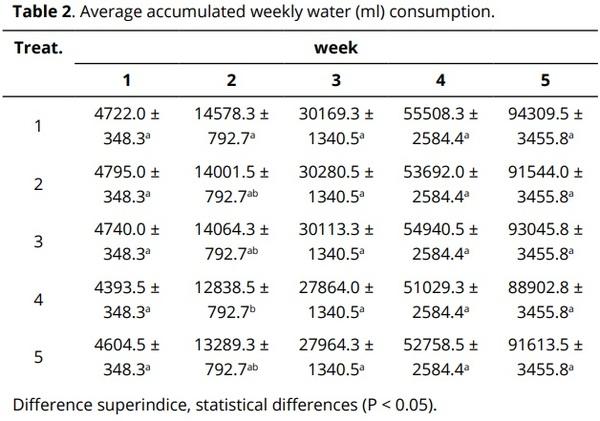
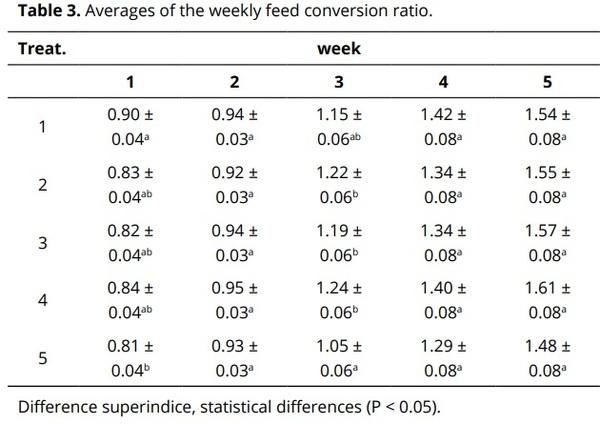
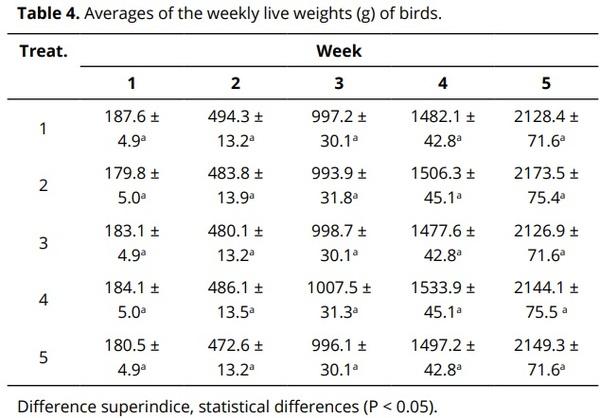
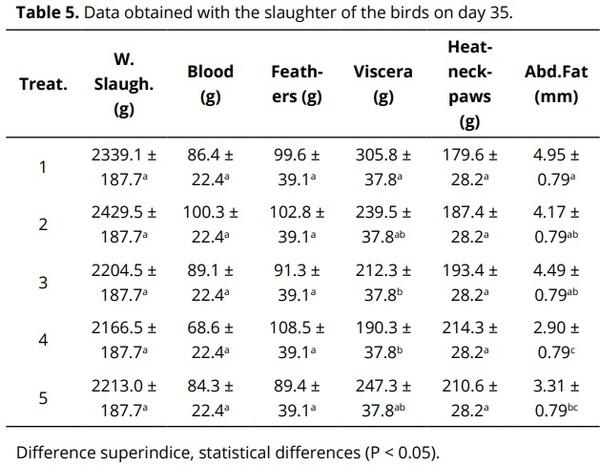
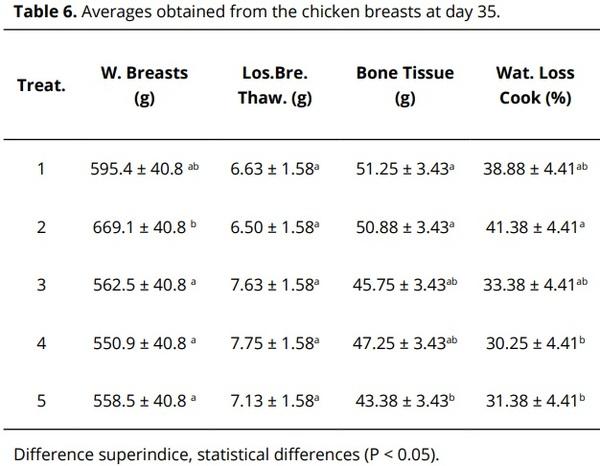

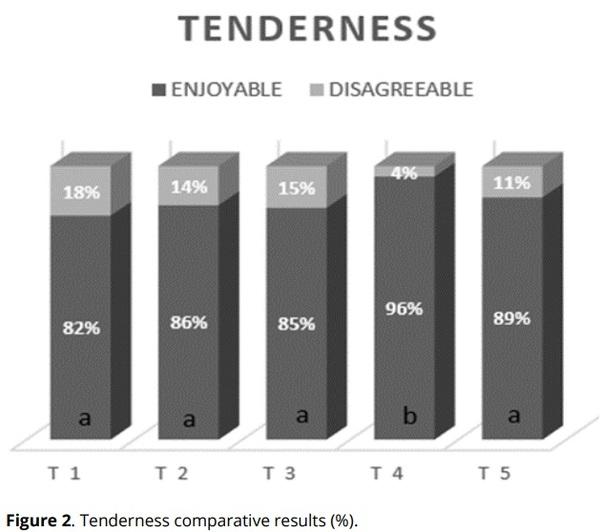
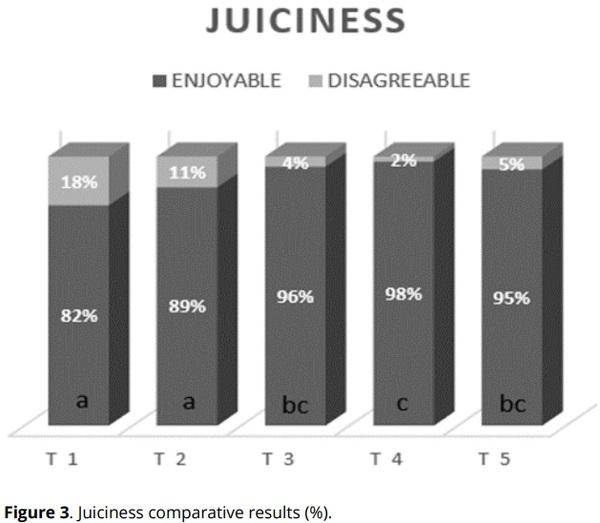










.jpg&w=3840&q=75)